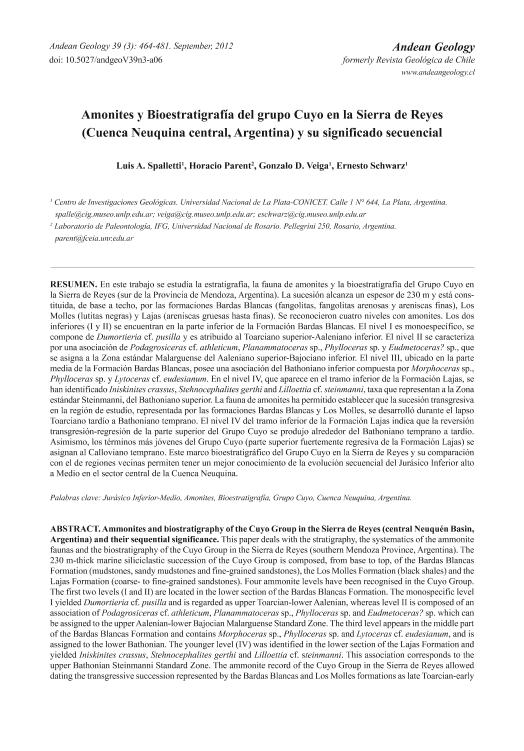Artículo
This paper deals with the stratigraphy, the systematics of the ammonite faunas and the biostratigraphy of the Cuyo Group in the Sierra de Reyes (southern Mendoza Province, Argentina). The 230 m-thick marine siliciclastic succession of the Cuyo Group is composed, from base to top, of the Bardas Blancas Formation (mudstones, sandy mudstones and fine-grained sandstones), the Los Molles Formation (black shales) and the Lajas Formation (coarse- to fine-grained sandstones). Four ammonite levels have been recognised in the Cuyo Group. The first two levels (I and II) are located in the lower section of the Bardas Blancas Formation. The monospecific level I yielded Dumortieria cf. pusilla and is regarded as upper Toarcian-lower Aalenian, whereas level II is composed of an association of Podagrosiceras cf. athleticum, Planammatoceras sp., Phylloceras sp. and Eudmetoceras? sp. which can be assigned to the upper Aalenian-lower Bajocian Malarguense Standard Zone. The third level appears in the middle part of the Bardas Blancas Formation and contains Morphoceras sp., Phylloceras sp. and Lytoceras cf. eudesianum, and is assigned to the lower Bathonian. The younger level (IV) was identified in the lower section of the Lajas Formation and yielded Iniskinites crassus, Stehnocephalites gerthi and Lilloettia cf. steinmanni. This association corresponds to the upper Bathonian Steinmanni Standard Zone. The ammonite record of the Cuyo Group in the Sierra de Reyes allowed dating the transgressive succession represented by the Bardas Blancas and Los Molles formations as late Toarcian-early athonian. The ammonite fauna identified in the lower section of the Lajas Formation (level IV) indicates that the change from transgressive to regressive conditions recorded at the upper part of the Cuyo Group occurred around early-late Bathonian times. The uppermost strata of the Cuyo Group (upper section of the Lajas Formation), having a well defined regressive signature, can be dated as lower Callovian. This relatively well constrained biostratigraphic framework of the Cuyo Group in the Sierra de Reyes and its comparison with neighbouring areas allowed for a better understanding of the sequential evolution in central Neuquén Basin during the late Lower to Middle Jurassic. En este trabajo se estudia la estratigrafía, la fauna de amonites y la bioestratigrafía del Grupo Cuyo en la Sierra de Reyes (sur de la Provincia de Mendoza, Argentina). La sucesión alcanza un espesor de 230 m y está constituida, de base a techo, por las formaciones Bardas Blancas (fangolitas, fangolitas arenosas y areniscas finas), Los Molles (lutitas negras) y Lajas (areniscas gruesas hasta finas). Se reconocieron cuatro niveles con amonites. Los dos inferiores (I y II) se encuentran en la parte inferior de la Formación Bardas Blancas. El nivel I es monoespecífico, se compone de Dumortieria cf. pusilla y es atribuido al Toarciano superior-Aaleniano inferior. El nivel II se caracteriza por una asociación de Podagrosiceras cf. Athleticum Planammatoceras sp., Phylloceras sp. y Eudmetoceras?
sp., que se asigna a la Zona estándar Malarguense del Aaleniano superior-Bajociano inferior. El nivel III, ubicado en la parte media de la Formación Bardas Blancas, posee una asociación del Bathoniano inferior compuesta por Morphoceras sp., Phylloceras sp. Y Lytoceras cf. eudesianum. En el nivel IV, que aparece en el tramo inferior de la Formación Lajas, se han identificado Iniskinites crassus Stehnocephalites gerthi and Lilloettia cf. steinmanni, taxa que representan a la Zona estándar Steinmanni, del Bathoniano superior. La fauna de amonites ha permitido establecer que la sucesión transgresiva en la región de estudio, representada por las formaciones Bardas Blancas y Los Molles, se desarrolló durante el lapso Toarciano tardío a Bathoniano temprano. El nivel IV del tramo inferior de la Formación Lajas indica que la reversión transgresión-regresión de la parte superior del Grupo Cuyo se produjo alrededor del Bathoniano temprano a tardío. Asimismo, los términos más jóvenes del Grupo Cuyo (parte superior fuertemente regresiva de la Formación Lajas) se asignan al Calloviano temprano. Este marco bioestratigráfico del Grupo Cuyo en la Sierra de Reyes y su comparación con el de regiones vecinas permiten tener un mejor conocimiento de la evolución secuencial del Jurásico Inferior alto a Medio en el sector central de la Cuenca Neuquina.
Amonites y bioestratigrafía del Grupo Cuyo en la Sierra de Reyes (Cuenca Neuquina central, Argentina) y su significado secuencial
Título:
Ammonites and biostratigraphy of the Cuyo Group in the Sierra de Reyes (central Neuquén Basin, Argentina) and their sequential significance
Fecha de publicación:
09/2012
Editorial:
Servicio Nacional de Geología y Minería
Revista:
Andean Geology
ISSN:
0718-7092
e-ISSN:
0718-7106
Idioma:
Español
Tipo de recurso:
Artículo publicado
Clasificación temática:
Resumen
Archivos asociados
Licencia
Identificadores
Colecciones
Articulos(CIG)
Articulos de CENTRO DE INVEST.GEOLOGICAS (I)
Articulos de CENTRO DE INVEST.GEOLOGICAS (I)
Citación
Spalletti, Luis Antonio; Parent, Horacio; Veiga, Gonzalo Diego; Schwarz, Ernesto; Amonites y bioestratigrafía del Grupo Cuyo en la Sierra de Reyes (Cuenca Neuquina central, Argentina) y su significado secuencial; Servicio Nacional de Geología y Minería; Andean Geology; 39; 3; 9-2012; 464-481
Compartir
Altmétricas




